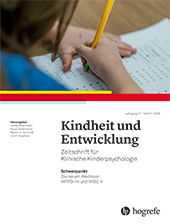Die neuen Wechsler: WPPSI-IV und WISC-V
Abstract
Zusammenfassung. Intelligenztests werden regelmäßig überarbeitet, um Leistungen von Testpersonen reliabel und valide einschätzen zu können. Die Veränderungen, die in den aktuellen Versionen der Wechsler-Tests für das Kindes- und Jugendalter (WPPSI-IV, WISC-V) umgesetzt wurden, bilden den aktuellen Forschungsstand zur Intelligenzdiagnostik ab. Aus Validierungsstudien mit spezifischen Stichproben und Fragestellungen können Testanwender wichtige Informationen zur Interpretation von Testergebnissen ziehen.
Abstract. Intelligence tests are regularly revised in order to be able to assess the performance of test participants reliably and validly. The changes that have been implemented in the current versions of the Wechsler tests for children and adolescents (WPPSI-IV, WISC-V) reflect the current state of research in intelligence diagnostics. Validation studies with specific samples and questions can provide test users with important information for interpreting test results.
Literatur
(in Druck). Predictive value of traditional measures of executive function on broad abilities of the Cattell–Horn–Carroll theory of cognitive abilities. Assessment.
(2012). Working memory: theories, models, and controversies. Annual Review of Psychology, 63, 1 – 29.
(2016). The role of Cattell-Horn-Carroll (CHC) cognitive abilities in predictiong writing achievement during the school-age years. Psychology in the Schools, 53, 787 – 803.
(2008). Differenzen im Intelligenzprofil bei Kindern mit Migrationshintergrund: Befunde zum HAWIK-IV. Kindheit und Entwicklung, 17, 75 – 89.
(2018). Welchen Einfluss hat ein Migrationshintergrund auf die kognitiven Leistungen in der WISC-V? Kindheit und Entwicklung, 27, 175-183.
(2013). Verhaltensinventar zur Beurteilung exekutiver Funktionen für das Kindergartenalter (BRIEF-P). Bern: Huber.
(2007). Intelligenzdiagnostik mit dem HAWIK-IV. Kindheit und Entwicklung, 16, 250 – 259.
(2008). Der allgemeine Fähigkeitsindex (AFI) – eine Alternative zum Gesamt-Intelligenzquotienten (G-IQ) des HAWIK-IV? Diagnostica, 54, 211 – 220.
(2018). Zum Zusammenhang von Verhaltensauffälligkeiten in exekutiven Funktionen und Intelligenzleistungen in der WPPSI-IV. Kindheit und Entwicklung, 27, 153-164.
(1997). Why g matters: The complexity of everyday life. Intelligence, 24, 79 – 132.
(2010). Intelligenz- und Aufmerksamkeitsleistungen von Jungen mit ADHS. Zeitschrift für Psychiatrie, Psychologie und Psychotherapie, 58, 299 – 308.
(2011). Kognitive Leistungsprofile motorisch und sprachentwicklungsverzögerter Vorschulkinder. Kindheit und Entwicklung, 20, 173 – 185.
(2018a). Umschriebene motorische Entwicklungsstörungen (UEMF): Weisen betroffene Kinder spezifische Intelligenzprofile auf? Kindheit und Entwicklung, 27, 14 – 30.
(2018b). Leistungsinventar zur objektiven Überprüfung der Motorik von 3- bis 6-Jährigen (LoMo 3 – 6). Göttingen: Hogrefe.
(2018). Zum Zusammenhang von motorischer und kognitiver Entwicklung im Vorschulalter. Kindheit und Entwicklung, 27, 142-152.
(2018). Knowledge is power for medical assistants: Crystallized and fluid intelligence as predictors of vocational knowledge. Frontiers in Psychology, 9, Art. 28.
(2012). Intelligence: New findings and theoretical developments. American Psychologist, 67, 130 – 159.
(2015).
CHC theory of intelligence . In S. GoldsteinD. PrinciottaJ. A. NaglieriEds., Handbook of intelligence (pp. 209 – 227). New York: Springer.(2018). Intelligenzdiagnostik bei Kindern und Jugendlichen mit ADHS: Eine Analyse der WISC-V-Leistungsprofile. Kindheit und Entwicklung, 27, 165-174.
(2006). Intelligenzdiagnostik. Kindheit und Entwicklung, 15, 71 – 75.
(Hrsg.). (2014). Wechsler Nonverbal Scale of Ability (WNV). Frankfur a. M.: Pearson Assessment.
(2007). Klinische Kinderneuropsychologie. Kindheit und Entwicklung, 16, 1 – 6.
(2015). Entwicklungstest für Kinder von 6 Monaten bis 6 Jahren – Revision (2., korr. Aufl.). Frankfurt a. M.: Pearson Assessment.
(2008). HAWIK-IV. Kindheit und Entwicklung, 17, 71 – 75.
(2017). Cognitive profiles in bilingual children born to immigrant parents and italian monolingual native children with specific learning disorders. Neuropsychiatric Disease and Treatment, 13, 109 – 116.
(2015). Intelligence and school grades: A meta-analysis. Intelligence, 53, 118 – 137.
(1904). ’General intelligence’, objectively determined and measured. American Journal of Psychology, 15, 201 – 293.
(2016). Intelligenz: kein Mythos, sondern Realität. Psychologische Rundschau, 67, 15 – 27.
(2012). Nonverbaler Intelligenztest SON-R 6 – 40. Göttingen: Hogrefe.
(2018). Nonverbaler Intelligenztest SON-R 2 – 8. Göttingen: Hogrefe.
(2018). Vorhersage von kognitiven Fähigkeiten in der WPPSI-IV durch den ET 6-6-R. Kindheit und Entwicklung, 27, 133-141.
(2016). Five Reasons to put the g back into giftedness: An argument for applying the Cattell-Horn-Carroll theory of intelligence to gifted education research and practice. Gifted Child Quarterly, 60, 3 – 15.
(1944). The measurement of adult intelligence (3rd ed.). Baltimore: Williams & Wilkins.
(2012). Wechsler Preschool and Primary Scale of Intelligence – Fourth Edition (WPPSI-IV). Bloomington, MN: Pearson.
(2014). Wechsler Intelligence Scales for Children – Fifth Edition (WISC-V). Bloomington, MN: Pearson.
(2017). Wechsler Intelligence Scale for Children – Fifth Edition (WISC-V) (dt. Bearbeitung durch F. Petermann). Frankfurt a. M.: Pearson Assessment.
(2018). Wechsler Preschool and Primary Scale of Intelligence – Fourth Edition (WPPSI-IV). (dt. Bearbeitung durch F. Petermann u. M. Daseking). Frankfurt a. M.: Pearson Assessment.



